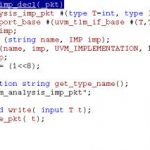You are currently viewing SemiWiki as a guest which gives you limited access to the site. To view blog comments and experience other SemiWiki features you must be a registered member. Registration is fast, simple, and absolutely free so please,
join our community today!
Design starts are the lifeblood of the semiconductor industry which is why we have been following the eSilicon STAR Platform since its introduction with great anticipation. The STAR platform was first launched about three years ago. Today, there are over 1,300 registered STAR users in 52 countries around the world.
The ASIC business… Read More
The EDA tools industry relies upon ongoing productivity enhancements to existing products, to manage increasing SoC complexity and to address shrinking design schedules. The source of ideas for enhancements can come from a variety of sources – e.g., customer feedback, collaboration with the foundries, and features found … Read More
For those of you who don’t know, GitHub is the crowdsourcing version of the defacto industry standard GIT source code management software. Currently, more than 14 million people have deposited more than 35 million software projects (mostly open-source) on GitHub making it the largest host of source code in the world.
Now think… Read More
Do not lose sleep worrying that your integrated circuits might fail during EOS/ESD events. Join us for the 38th annual EOS/ESD Symposium in Anaheim, CA in September. Experts on the field will address the latest research on EOS and ESD in the rapidly changing world of electronics.
As electronics continue to become commonplace in… Read More
The History of ASICs is well documented in our book “Fabless: The Transformation of the Semiconductor Industry” which illustrates the earliest forms of design start driven collaboration. The history of ARM is well documented in our book “Mobile Unleashed” which illustrates an entire company culture based on design start driven… Read More
UVM for developing testbenches is a wonderful thing, as most verification engineers will attest. It provides abstraction capabilities, it encapsulates powerful operations, it simplifies and unifies constrained-random testing – it has really revolutionized the way we verify at the block and subsystem level.
However great… Read More
My first brush with AI was a LISP class for my undergraduate degree. LISP, originated from MIT in 1958, was the language of choice for AI research and spawned a new class of computer hardware called LISP Machines in the 1980s. My first personal experience with AI was the HAL 9000 system from the 2001 Stanley Kubrik movie Space Odyssey.… Read More
An increasing percentage of SoC die area is being allocated to memory arrays, as applications require more data/instruction storage and boot firmware. Indeed, foundries invest considerable R&D resources into optimizing their array technology IP offerings, often with more aggressive device features than used for other… Read More
It is easy to forget the importance of academia’s role in the semiconductor ecosystem but it is important not to. If you look at the DNA of the semiconductor industry you will see how dependent we are on academic research for innovation and the necessary disruption that keeps us all gainfully employed. FinFETs are the first things… Read More
At the #53DAC earlier this month held in Austin, Texas I met up with Renee Donkers, the founder of Fractal Technologies. His company has been focused on improving the quality of semiconductor IP cells through the use of automated checking software. The highest area of growth in EDA as measured by the ESD Alliance is in the reusable… Read More




